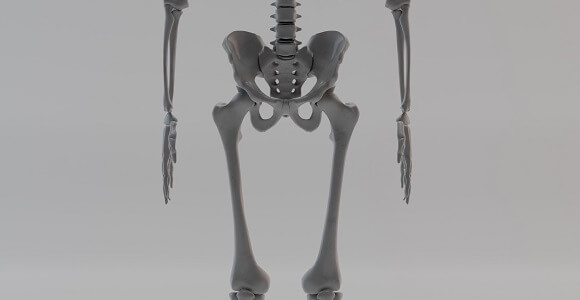You may be wondering about hip dips: if they’re normal, why they occur, or how to get rid of them.
Personally, I’ve always had indentations under my hips but I never paid attention to them before learning the term. Sometimes referred to as “hip dents” or “violin hips,” hip dips are a common physical feature that’s been added to the list of ludicrous body shaming concepts designed to make us feel insecure about our appearance.
If you’ve found yourself searching “how to get rid of hip dips” on Google or looking up hip dip workouts on YouTube, this post is for you. I interviewed Chris Allsobrook, personal trainer at OriGym Centre of Excellence, and Danielle Gray, Founder of Train Like A Gymnast, to hear their perspectives on the concept.
What are hip dips?
Hip dips is the term used for the indentation or inward curve that many people have directly below their hip bone, where the hip joint (e.g., the joint that connects your legs to your torso) is.
“Just like all bodies are different, some people are genetically predisposed to have a naturally occurring hip bone located higher than their femur, which causes a gentle inward curve of muscle and fat,” Gray explained. “It’s an anatomical bone structure differentiation as opposed to a skeletal muscle term that can be changed. Look at a human skeleton, and you’ll see what they are immediately.“

Hip dip causes
Hip dips are a normal part of human physiology. Whether you have them or not largely depends on your bone structure, as well as a few related factors.
According to Allsobrook, having visible hip dips also depends on how the skin stretches over the hip joint, the width of the hips, the distance between the greater trochanter (part of the femur) and the pelvic area, and body composition factors like how fat and muscle are distributed.
In some cases, fat can “fill in” the area where hip dips would be, while in other cases, it may collect above or below them instead, making them appear more prominent.
Are hip dips just fat?
No. Fat distribution can play a role in whether you have visible hip dips, but that’s not the same as simply having a certain amount of body fat.
More importantly, it’s not something you can change. “Contrary to popular belief, there’s no way for us to control where our body stores fat or muscle, so while these can be a factor in the appearance of hip dips, they’re out of our control,” Allsobrook said.
While some people find that their hip dips are more noticeable when they’re at a higher body fat percentage, that’s not universal. After I lost some weight through exercise, my hip dips actually ended up more noticeable.
Is it possible to get rid of hip dips?
It’s probably impossible to get rid of hip dips, at least through diet and exercise. There are lipo sculpting surgeries and filler injections that can fill in those dips, but that may seem extreme to most.
Gray said that building muscles in the surrounding hip and glute areas might help with hip dip visibility. She added that learning different posing techniques can help. However, results aren’t predictable, and there’s no guarantee that you’ll like your body better after training.
That’s because the main factor behind hip dips is your bone structure, and that’s not something you can change. Since there’s no way to spot reduce or spot gain fat, diet-related efforts won’t give you controllable results.
The emergence of hip dips
According to Google Trends, interest in the term “hip dips” started around 2017, which was around the same time when the curvaceous body type became popular.
The idealized image was of a woman with perfectly rounded hips that evenly taper as they reach her legs — no hip dips in sight! Many celebrities sporting such a physique were reputed to have undergone plastic surgery.
Beyond that, there’s also the amount of time we spend on social media, viewing a curated version of other people’s lives. Fashion and fitness influencers, in particular, strongly emphasize how they pose their body to create the illusion of slim waists and perfect curves.
Gray mentioned the damage done by photo editing as well. “As Photoshopping became more mainstream, we began to overly smooth our bodies and expect altered images to be the norm,” she said. “Previously, we knew magazine photos were edited. However, when our friends and people we knew started retouching their photos online, it became almost impossible to know what was real and what wasn’t, so comparison naturally occurs.”
I think that as many women found themselves striving for a similar physique, they learned that they couldn’t achieve that perfect roundness because of something entirely beyond their control. And in came a new insecurity that, frankly, none of us needed.
What to do about hip dips
Since you can’t diet or exercise your hip dips away, you might as well embrace them or at least be neutral towards them. I highly recommend looking up the #hipdip hashtag on Instagram to see the sheer variety of beautiful bodies with hip dips.
If you’re the kind of person who keeps up with influencers, consider seeking out ones with a similar body type to yours. I’m a huge fan of influencers like Bree Lenehan and Josephine Livin, who post side-by-side images of their posed and unposed bodies.
I also suggest reading up on body positivity and body neutrality. I go through big swings of loving and hating my appearance, so cultivating a neutral attitude has helped me feel healthier.
Own your body
For the most part, I don’t see why you or anyone else should worry about their hip dips, and neither does Gray. “The term itself frustrates me since the phrase is neutral but has been given a negative meaning,” she said. “They are dips in your hips. That is all. It’s similar to saying some people have curly hair. Yes, they do, and there’s nothing wrong with it.”
Now that I’ve noticed them, I can embrace my hip dips. They’re neither good nor bad — just another part of me. “The best thing you can do is strive to be the healthiest version of yourself physically and mentally,” Gray said.
Sure, picking up an exercise habit may have led to some visual changes I didn’t expect. But more importantly, it took care of niggling pains and allowed me to have a more functional body — I think that’s what’s truly worth celebrating, hip dips and all.





